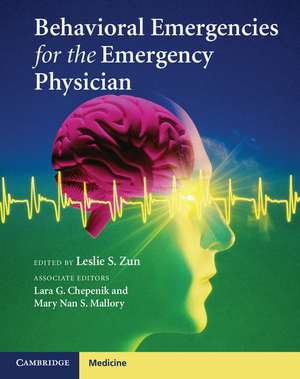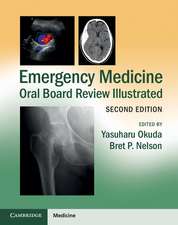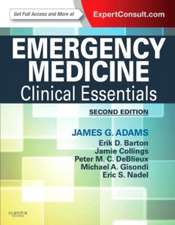Behavioral Emergencies for the Emergency Physician
Editat de Leslie S. Zun Lara G. Chepenik, Mary Nan S. Malloryen Limba Engleză Paperback – 20 mar 2013
Preț: 738.12 lei
Preț vechi: 776.97 lei
-5% Nou
Puncte Express: 1107
Preț estimativ în valută:
141.28€ • 153.52$ • 118.76£
141.28€ • 153.52$ • 118.76£
Carte tipărită la comandă
Livrare economică 21 aprilie-05 mai
Livrare express 14-20 martie pentru 223.47 lei
Preluare comenzi: 021 569.72.76
Specificații
ISBN-13: 9781107018488
ISBN-10: 110701848X
Pagini: 414
Ilustrații: 13 b/w illus.
Dimensiuni: 220 x 275 x 18 mm
Greutate: 1.04 kg
Ediția:New.
Editura: Cambridge University Press
Colecția Cambridge University Press
Locul publicării:New York, United States
ISBN-10: 110701848X
Pagini: 414
Ilustrații: 13 b/w illus.
Dimensiuni: 220 x 275 x 18 mm
Greutate: 1.04 kg
Ediția:New.
Editura: Cambridge University Press
Colecția Cambridge University Press
Locul publicării:New York, United States
Cuprins
Preface; Part I. General Considerations for Psychiatric Care in the Emergency Department: 1. The magnitude of the problem of psychiatric illness presenting in the emergency department; 2. Delivery models in emergency psychiatric care; Part II. Evaluation of the Psychiatric Patient: 3. The medical clearance process for psychiatric patients presenting acutely to the emergency department; 4. Advanced interviewing techniques for psychiatric patients in the emergency department; 5. Use of routine alcohol and drug testing for psychiatric patients in the emergency department; 6. Drug intoxication in psychiatric patients in the emergency department; 7. Drug withdrawal syndromes in psychiatric patients in the emergency department; Part III. Psychiatric Illnesses: 8. The patient with depression in the emergency department; 9. Assessment of the suicidal patient in the emergency department; 10. The patient with somatoform disorders in the emergency department; 11. The patient with anxiety disorders in the emergency department; 12. The patient with post traumatic stress disorder in the emergency department; 13. The patient with psychosis in the emergency department; 14. Personality disorders in the acute setting; 15. The patient with factitious disorders and malingering in the emergency department; 16. The patient with delirium and dementia in the emergency department; 17. The patient with excited delirium in the emergency department; 18. Medical illness in psychiatric patients in the emergency department; 19. Acute care of eating disorders; 20. Management of the emergency department patient with co-occurring substance abuse disorder; Part IV. Treatment of the Psychiatric Patient: 21. Use of verbal de-escalation techniques in the emergency department; 22. Use of agitation treatment in the emergency department; 23. Management of aggressive and violent behavior in the emergency department; 24. Restraint and seclusion techniques in the emergency department; 25. Use of psychiatric medications in the emergency department; 26. The patient with neuroleptic malignant syndrome in the emergency department; 27. Treatment of psychiatric illness in the emergency department; 28. Rapidly acting treatment in the emergency department; Part V. Special Populations: 29. Pediatric psychiatric disorders in the emergency department; 30. Geriatric psychiatric emergencies; 31. Disaster and terrorism emergency psychiatry; 32. Trauma and loss in the emergency setting; 33. Management of homeless and disadvantaged persons in the emergency department; 34. Management of neurobehavioral sequelae of traumatic brain injury in the emergency department; 35. Management of psychiatric illness in pregnancy in the emergency department; 36. Cultural concerns and issues in emergency psychiatry; 37. Rural emergency psychiatry; Part VI. Administration of Psychiatric Care: 38. Coordination of emergency department psychiatric care with psychiatry; 39. Integration with community resources; 40. The role of telepsychiatry; 41. Emergency medical services psychiatric issues; 42. Triage of psychiatric patients in the emergency department; 43. The Emergency Medical Treatment and Active Labor Act (EMTALA) and psychiatric patients in the emergency department; 44. Assessing capacity, involuntary assessment, and leaving against medical advice; 45. Best practices for the evaluation and treatment of patients with mental and substance use illness in the emergency department; 46. Improving emergency department process and flow; 47. Physical plant for emergency psychiatric care; 48. Legal issues in the care of psychiatric patients; 49. Law enforcement and emergency psychiatry; 50. Research in emergency psychiatry; Index.
Descriere
This comprehensive, go-to volume features cutting edge discussion of the emergency department management of mental health patients.









